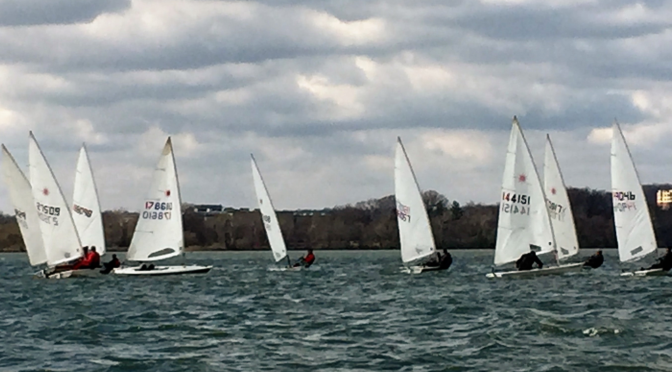Thanks for John Van Voorhis and Cliff Bartlett for doing the RC today and working diligently to square the line and give us a nice mix of Olympic and WL courses and they even used the flags!! 🙂 Also a big thanks to John for offering to help me launch and retrieve the 19’ boat when I had RC last week.
I hope no one reading this is hoping for a lot of technical insight as to shifts, persistent or otherwise, I’m pretty sure I would not know one from the other. Overall my mantra is to slog it out as best I can, keep the boat flat and hike as much as my body will allow me, and of course try not to make any mistakes or cut things too close.
This is the best I know:
Starts:
First, I benefited greatly from having ½ the fleet coming late to the start of race 1. That gave me a big boost in the day’s score. Being on time paid off for me.
When the start line is square (as it was in most races today), I find I sometimes do better coming in on port and searching for a hole about 15-30 seconds from the start. You have to be really quick though with your tack, because there is little time and space between the starboard tackers. So it’s a little risky. In one case, however, it really paid off because I was able to stay on port by threading the needle as they say, and in that particular race ( I forget which one) a port tack was favored. In that last few seconds before the start you really do need to head down off the wind and power up, and accelerate so that you are up at full speed when the gun goes off. That seems to be the only way to have a good race. So if you are going to concentrate and be on your game, these first 10 or 20 seconds after the gun goes off are the most critical.
Upwind:
I had my cunningham very tight, outhaul about 2” off the boom at mid point, and the vang ¾ on. The tight cunningham helped me when the puffs came so as to not be overpowered. I pretty much tried not to sail out to the lay lines too much as a shift in wind could easily gain you several boats if you tack quick enough on the header. As it was very quirky and puffy, I did my best to ‘ease-hike-trim’ whenever I could, and a few times I could really feel it working, and I was gaining on other boats. As for when I would tack, that pretty much was determined by my looking at the luff of my sail, and when it started to collapse in (ie a header), I would throw in a tack.
Reach:
On the reaches, I would pull my board up ½ and ease the cunningham off all the way and then adjust the vang to as to get the best sail shape I could get. My cunningham does not seem to come off unless I go to the mast and pull on the slack of the line, so I found myself doing that a lot today.
Downwind:
Cunningham all the way off, board up 1/2 , outhaul about 2” off the boom at mid point, and the vang adjusted until I saw a good sail shape, which oddly, meant putting on quite a bit of vang. I was worried about death rolling in the puffs, and managed to stay flat by looking back all the time for the darkness in the water, and then when it hit, I would use aggressive mainsheet trimming to dampen out the oscillations. But when the wind comes from the west like that, it can cause a lot of deathrolling. So on days when it’s windier, if I feel I might deathroll, I quickly sail off on a reach and pop up on a plane and do the best I can that way. Better to be up on a plane, sail a little longer, and then gybe when you feel in control (or even chicken-tack if it’s really windy). Nothing is slower than going for an unwanted swim.
One final thought, it pays to look up at your sail shape as often as you can. I am doing this now more than I used to in the past ( I think Len mentioned that once or twice to me). So in going downwind, again for some reason it seemed like I had to put on vang for a nice shape, and I know most people ease their vangs going downwind, so I don’t quite know what caused that. Maybe it’s the new sail that has not yet broken in.
Best,
Jim Klein
2017_2018 PRSA Laser Frostbite Series #4

